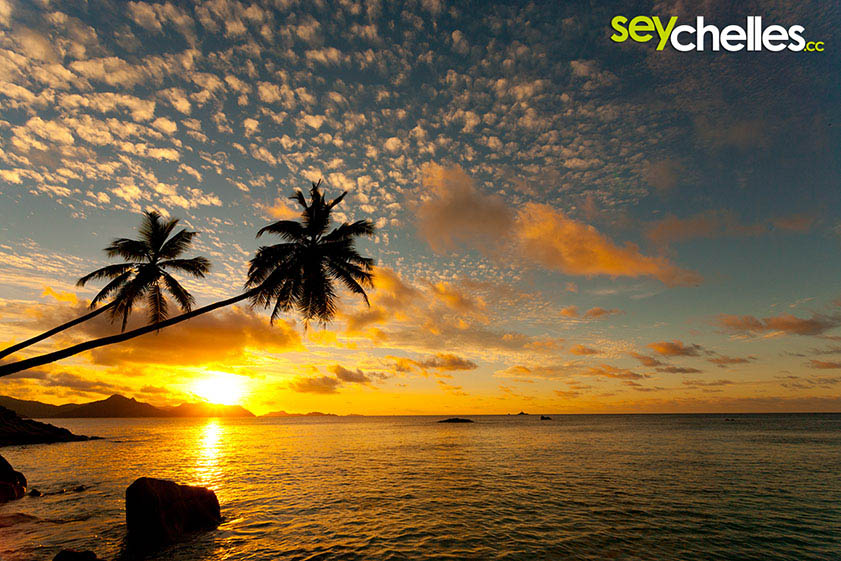The beaches of La Digue belong to the most beautiful beaches in the world. Let us introduce you to these amazing wonders of nature. We don´t yet have all of them covered, but we work hard getting them online as soon as possible. We will start at Anse Cocos and from there we´ll circle the island clockwise, featuring the tiniest beach of La Digue, Anse Songe to the biggest beach, Grand Anse - enjoy!!!
being the third of the great Seychelles beach triplets, Anse Cocos is accessible via Grand Anse and Petite Anse on La Digue. We have a description of the Anse Cocos Trail available for you and there will soon be a dedicated video of the trail. While it is not really difficult to get there, it is wise to know which path to take and it is even wiser to take enough water with you. There is no access to drinking water after you left Grand Anse. And at times the small kiosk at Grand Anse is closed too. However, Anse Cocos for many Seychelles tourists is a dream come true. Lunate-shaped with white sand and beautiful waves. For us, it is one of the highlights of a Seychelles and La Digue vacation. You need to know that shadow is rare, and like all the beaches on this part of La Digues coast, it is not perfect for swimming. However, at the northern end of the bay, there is a small pool between the granite rocks that is perfect for having a bath. The area behind Anse Cocos gave the beach its name. It is a former Coconut plantation and the ruins are still visible in the swamp. 
Petite Anse is just a few minutes walk from Grand Anse on La Digue. Despite being steep, the path is not really difficult. It might become pretty hard though if you run out of water or are handicapped with a bad knee or hip. Petite Anse usually is much calmer than Grand Anse, especially at low tide. However, a sign telling you to be aware of strong currents reminds you to take care. While the beach is one of the flattest of the Seychelles, some caution sure is appropriate.
Strangely Petite Anse is one of the most deserted beaches of the Seychelles. One of the reasons might be that there is hardly any shade available (especially until afternoon), the other one being that most people that come here are on their way to Anse Cocos, and only stay for a few minutes. If you want to see more from Petite Anse, watch our movie aerials of Grand Anse and Petite Anse. 
Grand Anse on La Digue for us is one of the most breathtaking beaches not only on the Seychelles. It is wide, wild and beautiful. Most of the time, there is quite a surf and waves crash at the sandy beach, leaving a white squall every few seconds. A big sign reminds you that going into the water may be dangerous due to strong currents. So this beach is not the perfect location if you want to teach your kids how to swim. However, the sheer beauty of this place is way worth the time it takes to get here, and you can always get your toes wet before you might consider proceeding to Petite Anse, or Anse Cocos. Be sure to read our Anse Cocos Trail description or watch the video that will soon be online on our youtube channel. 
Anse Songe is about 15 minutes walk from Grand Anse on La Digue. It is only accessible through a small track that heads inland as soon as you leave the paved road coming down the mountains from the other side of La Digue. Anse Songe is no beach for swimming, snorkelling or sunbathing because getting into the water is really hard and there is no shade at all. However, this tiny beach is great for shelling and for this very reason probably the best one on La Digue or any other of the big islands of the Seychelles. What you should keep in mind is that you must not bring any of the shells back home with you because of the regulations on the Seychelles. So be aware. 
Grand l´Anse is just south of famous Grand Anse on La Digue. Don´t exchange these two, their name is pretty similar ;). If at all, most people know it from passing by on their probably guided tour to Anse Marron. Other than that, hardly anybody ever finds his way here. Unfortunately, Grand l´Anse doesn´t offer much besides a scenic view. Swimming is close to impossible due to the many waves that crash against the rocks laying in this small bay. There isn´t really shade worth mentioning, so passing by, sitting down for a few minutes and continuing the walk is what most people do. 
Anse Marron is a remote beach on the very southern tip of La Digue. The path here is not easy to find and after trying 2 times from two different sides, we ourselves decided to take a guide. The remoteness of this place along with the amazing granite blocks makes this beach and the trip one of the must-sees on La Digue. Our images don´t do justice to Anse Marron, they are just screen-grabs from the video of our Trail with Robert Agnes. We plan better images for our next visit. The granites on Anse Marron form a nice big bathtub for swimming and bathing. Something that´s rather rare on this beach though is shadow, so be prepared. 
Anse Aux Cedres is actually a really nice beach in extension of Anse Source d´Argent on La Digue. To reach it you have to wade through water - take care when the tide sets in!!! Since it´s really not easy to access compared to other beaches, it is deserted most of the day. Usually, you´ll find a few shady spots before late afternoon and swimming would be nice at higher tides - but then again you shouldn´t be here when high tide sets in because you are going to have a hard time getting back. 
Anse Pierrot is the next beach after the most famous Anse Source d´Argent, facing south. If Source d´Argent is a little too crowded for your taste, but you like the look and feel of the shallow water and huge granite rocks, this beach is the place to go. 
Anse Bonnet Carre can be found when you continue after Anse Source d´Argent to the south of La Digue. It´s not the most beautiful of all beaches of the Seychelles, but nobody will ever stay here for long. Most people are on their way to or come from Anse Marron. Anse Bonnet Carre doesn´t offer any shade, nor is it a great place to swim. At times there is a lot of seaweed around too. Of course, compared to beaches in other countries in the world it is amazing - but hey, you´re on the Seychelles and you´re getting spoiled every day ;). 
Anse Source d´Argent is probably the most famous of the Seychelles beaches. It was voted the most beautiful beach in the world numerous times and is unique with its huge granite boulders scattered along the shoreline. This beach sure is a must on your list of Seychelles places to go. Unfortunately, it is also on the list of others and it can get a bit crowded at times – but only compared to other Seychelles beaches. Many people come and visit in the morning when the ferry for the day-trip from Mahé or Praslin arrives. But the best time to visit is noon to sunset because the sun will light the beach really well in the afternoon – great for taking pictures. Anse Source d´Argent has been the setting for many series, photo shootings and films and if you´re lucky enough, you might even observe a shooting. Lately, there is a bar at the end of the beach where you can get cold drinks and refreshments. The beach itself offers some shady places, but they can get rare in high season. Swimming is good since the beach is protected from a reef and some people even say that snorkelling is nice, but it depends on what you have seen before. There is an entrance fee for this beach because you have to walk through Union Estate Park. 
Anse Union is the waterfront of L´Union Estate, a wonderful parklike property that is some sort of open-air-museum, showing visitors how life was like when people earned their money with Copra and Vanilla. You can read more about L´Union Estate in our dedicated article. The beach is nice, but nothing spectacular. If you wonder what the rails are that cross the beach: they were used back in 1986 for the film Pirates with Walter Matthau. 
Anse La Reunion on La Digue is a pretty long stretch of coastline that you wouldn´t usually combine all in one name. It starts at the jetty in La Passe and leads all the way down to L´Union Estate. Along the way there are several hotels and private homes, so the beach isn´t easily accessible everywhere. Not all of it is a proper beach area, but some stretches are really nice. The water like almost everywhere on this side of the island is rather shallow, especially at low tide. Some parts have nice shady trees, others don´t. In general, we don´t really recommend to go for this beach, except you live in one of the hotels nearby and are too lazy to get to one of the other really great beaches on La Digue. Again - if you are used to beaches in other countries, you´d be totally happy. But you are on La Digue, the island with some of the most beautiful beaches in the world. 
Anse Sévère is an increasingly popular beach close to the northern tip of La Digue. Going there, don´t be surprised to drive right through a hotel. The „Le Domain de L´Orangeraie“ is situated on both sides of the road. At high tide, Anse Sévère is a really nice place to swim. At low tide, the water barely touches your ankles. Anse Sévère is one of many examples on the Seychelles, how a few palm trees that used to bend over the beach can change the look of it completely (read more about bending palm-trees) The two palm-trees you see on the sunset image, unfortunately, don´t exist anymore? Compared to other beaches, Anse Sévère offers some nice and shady places to hide from the sun and the surf is usually rather soft. 
Anse Patates is a very tiny, yet really beautiful beach right at the Patatran and L´Ocean hotels. It´s safe to say that it´s the smallest beach after Anse Songe on the west coast. Considering that and also the proximity of the two hotels, it is quite crowdy compared to other La Digue beaches. Anse Patates is said to be good for snorkelling. We´ve been there, but as always it depends on what you´ve seen before. If you have never been snorkelling on a really great reef you´ll sure be happy, otherwise not so much. However, it is definitely one of the best beaches for swimming, once you went over the shallow area and there is also quite some shade of trees. 
Anse Gaulette has a strange charm. There is some wildness in this beach and the sand seems really clean and is free of seaweed most of the time. What adds to the charm and is distracting at the same time is a wall that was built long ago to keep the water from flooding the "road" nearby. The waves destroyed the wall in time and also the road, so there is a short passage of dirt road on your way towards the south right at Anse Gaulettes. If you manage to get out into the deeper waters you can even swim and there are some trees that will give you shade before you continue your bike-ride. 
Anse Banane is almost as beautiful as its neighbouring beach Anse Fourmis, but usually fewer people stop here longer than a few minutes. Tourists have a habit of biking along the road until they reach the dead end and staying on the beach closest to it ;). If you rather like a beach for your own, chances are that Anse Banane is your place to go. Similar to Anse Fourmis, swimming or bathing is rather difficult due to the shallow waters, but usually, it is a little bit deeper here. A few palm-trees also provide shade, so Anse Banane is a nice hideaway for a few hours. 
Anse Fourmis is the last beach on the East side of La Digue that is easy to access, coming along the road from the north. This beach is definitely attractive and many people stay there for a while before they go back on their bikes. During high tide, it can become a little narrow. There are a few trees that will give you some shade, but swimming is rather difficult unless you walk or wriggle over the reef into the ocean. But be aware that there can always be strong currents. Take some water with you when you plan to visit the beaches in this area because there is not much available here. 
Anse Caiman is one of the beaches on La Digue that is rather hard to access. You have to leave your bike at the dead end and climb along the rocks or into the bushes on a small path. It´s also not particularly beautiful, great for swimming or offers a lot of shade compared to other beaches. What makes this beach attractive is the challenge to get there. Some people also see the path and wonder where it leads to and follows it without knowing where they´ll turn up. Once you are there, you´ll probably go back again. Anse Cocos is not far away, but the path is REALLY hard to find and exhausting. Even though it´s a short distance it can take hours to get there. Taking the way to Anse Cocos from the other side via Grand Anse is much more beautiful and way easier. 























































